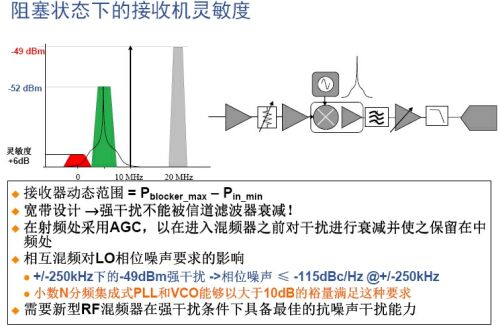He said at this year's IIC-China exhibition: "For China, the TD-SCDMA system will evolve towards TD-LTE. The initial LTE deployment is expected to cover the existing HSPA or 2G while evolving to an all-IP network. Network standards. "According to the 3GPP Rel 8 to be announced in 2009, the download rate of LTE will reach 100Mbps, the upload rate will reach 50Mbps, and the data modulation technology will use OFDMA to support higher data rates, he added.

So, what requirements does 3.5G LTE place on base stations and terminals? David said that 3.5G LTE must achieve lower cost-per-bit on new frequency bands, support variable channel bandwidths of 1.4 to 20MHz, support 100Mbps / 50Mbps download / upload data rates, and effectively limit mobile phone power consumption Using open interface network architecture. The initial test results have shown that the 3.5G LTE download data rate efficiency is more than 3 times the current HSPA.
Such a high data rate puts stricter requirements on the phase noise of the EVM and the local oscillator, and the support of variable channel bandwidth also requires the power amplifier to achieve high linearization in a wider frequency band. So, how should the 3.5G LTE base station signal transmission and reception architecture be implemented?
In theory, the 3.5G LTE transmission architecture can still use the RF-baseband direct down-conversion architecture and RF-IF-baseband IF conversion architecture in the 2G / 3G era. The two architectures have their own advantages and disadvantages. The direct down-conversion architecture has a low cost, but its performance is worse. The implementation cost of the IF conversion architecture is higher, but the performance is better. Regardless of the architecture, the typical EVM performance of PLL for phase jitter is less than 1% rms.

The overall performance requirements of the LTE transmission channel are: 1) 3.5G LTE spectrum quality and radiation limits should meet the existing 3G WCDMA specifications; 2) Single carrier LTE transmitter can be very similar to the 3G architecture; 3) EVM and spectrum quality It is a key indicator; 4) The dynamic range of the DAC is determined by the number of LTE (or WCDMA) carriers transmitted. For multi-carrier designs with high dynamic range, a 16-bit DAC is recommended. 5) The current broadband IQ modulator in the industry can provide the necessary dynamic range: SFDR = 2/3 (OIP3-NSD)> 80dB. 6) In order to get the best EVM performance, it is recommended to choose a broadband decimal-N synthesizer with integrated VCO. 7) In order to meet the requirements of spectrum quality and high PAR OFDM, a high linearity preamplifier and power amplifier must be selected.
For the receiving channel, if you choose the IF conversion architecture, then the impact of choosing high IF (single conversion) and low IF (second conversion) on the receiving channel is also different. For example, if a high IF is selected, the ADC linearity is good, the ADC noise performance is also good, the system complexity is lower, the channel selectivity is good, and the system cost is lower due to lower complexity and fewer conversion stages. But the disadvantage is that the sensitivity to jitter / PN is high, the cost of the converter is higher, and the converter power required to achieve better linearity is also higher.
If low IF is selected, the ADC linearity will be better, the ADC noise performance will be better, the sensitivity to jitter / PN is lower, the channel selectivity is better, the converter cost is lower, and the converter power is also lower However, the disadvantage is that the system complexity is higher (due to the addition of a conversion stage), and the system cost will be higher due to the greater number of components in the signal chain.
If you choose a direct down conversion architecture, there are also advantages and disadvantages. The advantages include: good converter performance, very simple signal chain and architecture, lower component count, and lower system cost. Disadvantages include: the quadrature error of the gain / phase / non-quadrature I & Q signal is large, there is a DC offset problem, and the signal chain may be difficult to set up and maintain.
In general, there is no change in the frame structure compared to TD-SCDMA. There is no difference between LTE FDD and TD-LTE in the receiving sensitivity level of the existing standard. However, LTE requirements are significantly more stringent than TD-SCDMA! If the existing TD-SCDMA platform cannot provide sufficient margin, the main receiving channel may have to be redesigned. Software and DSP need to be upgraded to meet the new requirements of scalable OFDMA for signal processing and scheduling.
Best Budget I7 Laptop is everyone eager to. Laptop Intel Core i7 is the No. 1 processor clients choose when they are searching for a performance Gaming Laptop,cause it`s of excellent powering, bigger Solid State Drive, usually 512GB based, full HD 16:9 aspect ratio slimmer display bezels, bigger battery-12000mAh-no need to worry lack of power, fingerprint reader, backlight keyboard, etc. What is intel Core I7 Laptop Price? Usually 300-400usd. You can get Intel i7 11th Generation Laptop, Intel i7 10th Generation Laptop, Intel I5 11th Generation Laptop, Laptop I3 11th Generation,etc. 15.6 or 14 inch all available for i7 processor.
Cooperating with us, you just need to share all your requirements details, like size, cpu, ram, rom, battery, fingerprint, backlight, enter button numbers, SSD+HDD or only SSD ok, if need oem service, if need logo position, special apps preinstall if need, etc. Can provide matched and value feedback in 1-2 working days.
The reason why clients choose us is that just half of DOA than others, longer warranty time, smaller MOQ, fast delivery, competitive cost, good after-sale service, etc.
Laptop Intel Core I7,Intel Core I7 Laptop Price,Best Budget I7 Laptop,Intel I7 11th Generation Laptop,Intel I7 10th Generation Laptop
Henan Shuyi Electronics Co., Ltd. , https://www.shuyiaiopc.com
